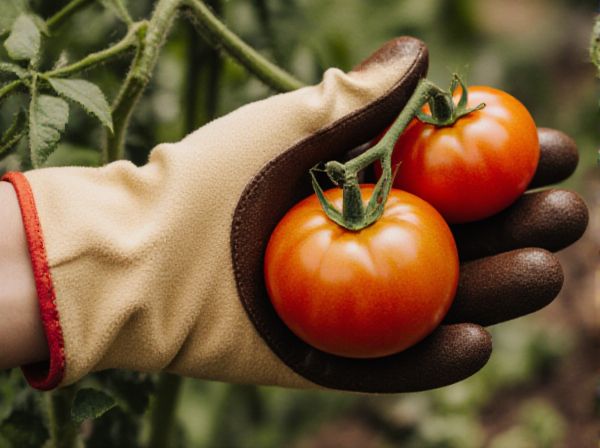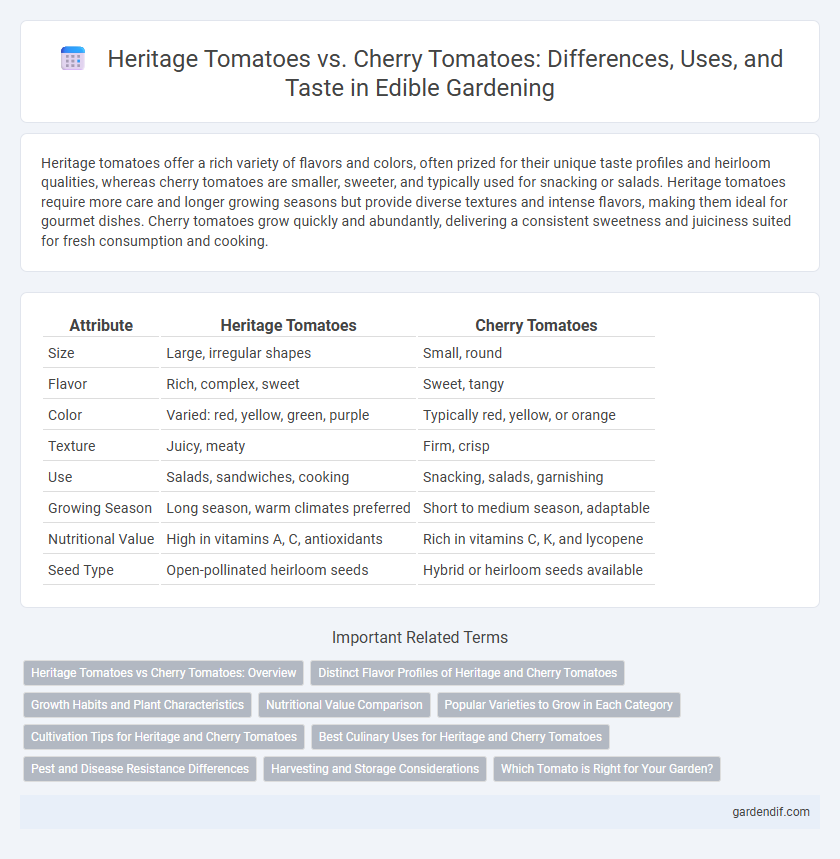
Heritage Tomatoes vs Cherry Tomatoes Illustration
Heritage tomatoes offer a rich variety of flavors and colors, often prized for their unique taste profiles and heirloom qualities, whereas cherry tomatoes are smaller, sweeter, and typically used for snacking or salads. Heritage tomatoes require more care and longer growing seasons but provide diverse textures and intense flavors, making them ideal for gourmet dishes. Cherry tomatoes grow quickly and abundantly, delivering a consistent sweetness and juiciness suited for fresh consumption and cooking.
Table of Comparison
| Attribute | Heritage Tomatoes | Cherry Tomatoes |
|---|---|---|
| Size | Large, irregular shapes | Small, round |
| Flavor | Rich, complex, sweet | Sweet, tangy |
| Color | Varied: red, yellow, green, purple | Typically red, yellow, or orange |
| Texture | Juicy, meaty | Firm, crisp |
| Use | Salads, sandwiches, cooking | Snacking, salads, garnishing |
| Growing Season | Long season, warm climates preferred | Short to medium season, adaptable |
| Nutritional Value | High in vitamins A, C, antioxidants | Rich in vitamins C, K, and lycopene |
| Seed Type | Open-pollinated heirloom seeds | Hybrid or heirloom seeds available |
Heritage Tomatoes vs Cherry Tomatoes: Overview
Heritage tomatoes, also known as heirloom tomatoes, are open-pollinated varieties prized for their diverse flavors, colors, and shapes, often grown from seeds passed down through generations. Cherry tomatoes are small, round, and typically sweeter, known for their bite-sized convenience and high sugar content, making them popular in salads and snacking. Heritage tomatoes tend to have thicker skins and more complex taste profiles, while cherry tomatoes offer uniform sweetness and crisp texture, distinguishing their culinary uses and nutritional benefits.
Distinct Flavor Profiles of Heritage and Cherry Tomatoes
Heritage tomatoes exhibit a rich, complex flavor with sweet, tangy, and sometimes smoky notes, often described as more intense and nuanced compared to cherry tomatoes. Cherry tomatoes typically offer a bright, crisp, and consistently sweet taste that bursts with freshness, making them ideal for snacking and salads. The distinct flavor profiles of heritage and cherry tomatoes reflect their differing cultivars and growing conditions, contributing to unique culinary applications.
Growth Habits and Plant Characteristics
Heritage tomatoes typically exhibit indeterminate growth habits, producing larger vines that can reach several feet in length and require staking or caging for support, while cherry tomatoes often have more compact, bushy growth suited for container gardening. Heritage varieties tend to develop larger, irregularly shaped fruits with thicker skins and deeper coloration, valued for their rich flavor profiles. Cherry tomatoes produce smaller, round fruits in clusters, with higher yields per plant and faster maturation times, making them ideal for continuous harvest throughout the growing season.
Nutritional Value Comparison
Heritage tomatoes contain higher levels of antioxidants such as lycopene and vitamin C compared to cherry tomatoes, supporting better immune function and skin health. Cherry tomatoes offer concentrated amounts of essential nutrients like potassium and folate, which aid in cardiovascular health and cell metabolism. Both varieties provide dietary fiber and hydration but heritage tomatoes generally deliver a broader spectrum of micronutrients.
Popular Varieties to Grow in Each Category
Heritage tomatoes, such as Brandywine, Cherokee Purple, and Green Zebra, are prized for their rich flavors and diverse colors, making them popular among home gardeners seeking unique, heirloom varieties. Cherry tomatoes like Sungold, Sweet 100, and Black Cherry are favored for their small size, sweetness, and prolific yields, ideal for snacking and salads. Both categories offer distinct growing benefits, with heritage tomatoes providing robust, complex tastes and cherry tomatoes delivering ease of harvest and consistent productivity.
Cultivation Tips for Heritage and Cherry Tomatoes
Heritage tomatoes thrive in well-drained, nutrient-rich soil with consistent watering to prevent cracking and ensure deep flavor development. Cherry tomatoes prefer full sun exposure and benefit from staking or cages to support their vigorous growth and prevent fruit rot. Both varieties require regular pruning of suckers to promote airflow and reduce fungal diseases, enhancing yield and fruit quality.
Best Culinary Uses for Heritage and Cherry Tomatoes
Heritage tomatoes offer rich, complex flavors ideal for fresh salads, gourmet sandwiches, and slow-cooked sauces where their unique taste can shine. Cherry tomatoes provide a sweet, tangy burst perfect for snacking, roasting, or enhancing pasta dishes with vibrant color and concentrated juice. Both varieties excel in recipes highlighting their texture and flavor intensity, with heritage tomatoes favored for depth and cherry tomatoes for brightness.
Pest and Disease Resistance Differences
Heritage tomatoes generally exhibit greater genetic diversity, which contributes to enhanced pest and disease resistance compared to cherry tomatoes. Cherry tomatoes, often bred for uniformity and size, tend to be more susceptible to common tomato ailments like blight and aphid infestations. Understanding these resistance differences can guide growers in selecting varieties best suited for organic or low-pesticide cultivation.
Harvesting and Storage Considerations
Heritage tomatoes require careful handling during harvesting due to their delicate skin and susceptibility to bruising, making early morning picking ideal to preserve freshness. Cherry tomatoes have a thicker skin and are less prone to damage, allowing for more flexible harvesting times and easier transport. For storage, heritage tomatoes should be kept at room temperature to maintain their flavor and texture, while cherry tomatoes can be refrigerated briefly to extend shelf life without significant loss of taste.
Which Tomato is Right for Your Garden?
Heritage tomatoes offer diverse flavors, colors, and larger fruit sizes ideal for gardeners seeking variety and traditional taste, while cherry tomatoes provide abundant, bite-sized fruits perfect for salads and snacking. Heritage tomatoes typically require more space and longer growing periods, making them suitable for gardeners with ample time and garden area. Cherry tomatoes thrive in smaller spaces and containers, offering high yields with less maintenance, making them an excellent choice for compact gardens or beginner gardeners.
Heritage Tomatoes vs Cherry Tomatoes Infographic

 gardendif.com
gardendif.com